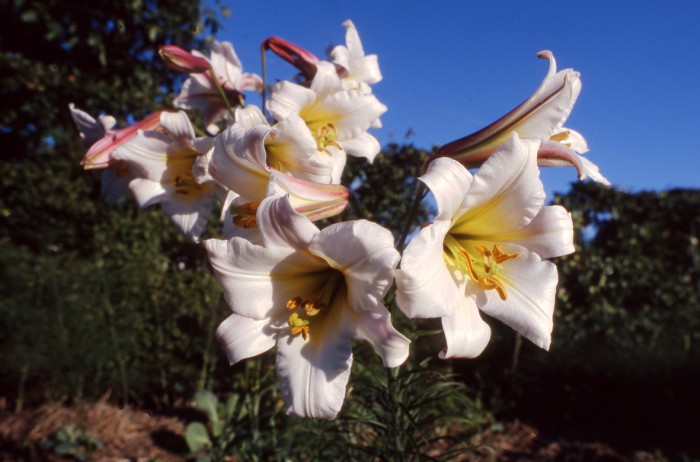Most Lilies don’t need to be in a greenhouse as they’re perfectly hardy. Of course amongst such a huge family there are tender sorts but generally those most commonly grown are happy outdoors all year round.

However there’s one very good reason for growing these under cover and that’s Lily beetles. These have devastated lilies wherever they’ve reached. The beetle is pretty reddish orange but the disgusting grubs look like bird droppings (they cover themselves with their own filth) and consume the foliage resisting most treatments other than continuous hand picking, sadly few lilies survive this for long. It seldom finds it’s way under cover and so here we can grow our lilies unmolested, and of course they’re even better for the warmth. This enlarges the flowers and without rain they stay pristine longer (and if we cut off their pollen bearing stamens so the flowers cannot be fertilised they stay perfect for longer still.)
Perhaps we might be fearful of the many alleged complications involved as these plants are reputedly rather particular, but actually they’re easily satisfied in practice. A few like full sun though many more prefer light shade so most are happy in less bright parts of the greenhouse leaving the sunnier places for others. The majority need no heating as they’re hardy, and dormant in winter, but they do need good ventilation and must never get hot.
Many lilies dislike lime in their compost but few really need it, and so almost all will thrive in a rich compost with plenty of leaf mould, as long as it’s well drained. Indeed that’s a crucial point; put a thick layer of coarse material in the bottom of their pots (or rather big heavy tubs as many may reach shoulder height under cover) as well as grit in their compost.
Apparently the most challenging aspect is that some need to have their bulbs deeply buried and others shallow. The reason is those needing deep planting also root from their stems, the lower roots feeding the leaves and bulb, and the stem roots pumping up the flowers. Even so, it’s not really that complicated; L. candidum (the old cottage garden white or Madonna) and L. giganteum need to be just under the surface but most other non-stem rooting lilies, such as the Turks cap Martagon, need be buried about two and a half times the height of their bulbs.
Meanwhile the majority of species such as the superb Regal lilies and the fantastic modern hybrids are stem rooting and need to be buried at least five or six inches / 12-15cm -which is often about two or three times the depth of most bulbs anyway! But if in any doubt plant deeper. So although lilies have this reputation for a host of problems that was because of poor virus infected stocks, buying top quality bulbs will ensure you are unlikely to encounter most of these. Otherwise care is simple; water with clean rainwater, feed lightly and as the foliage dies down in winter do not dry off their compost too completely.


